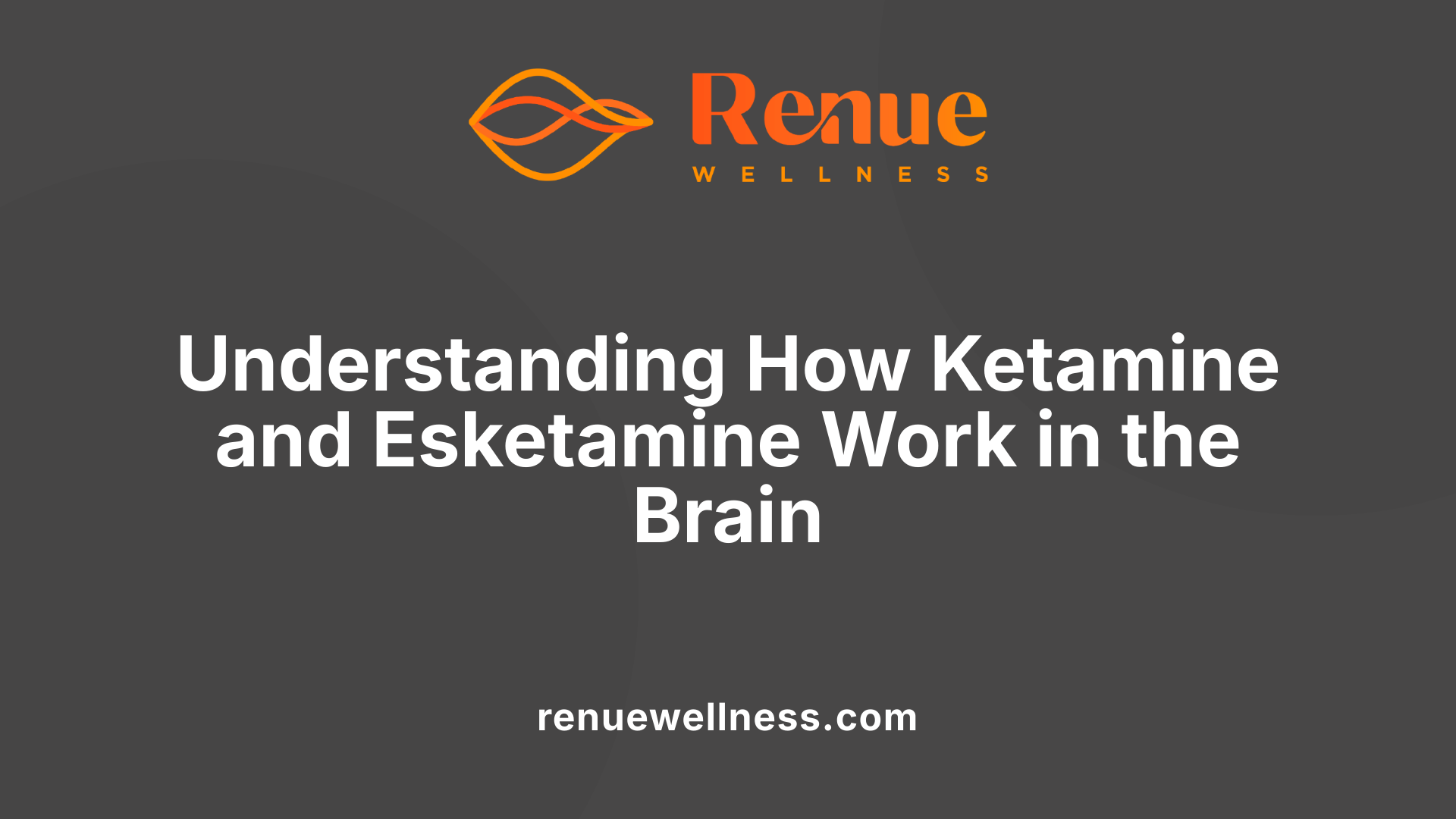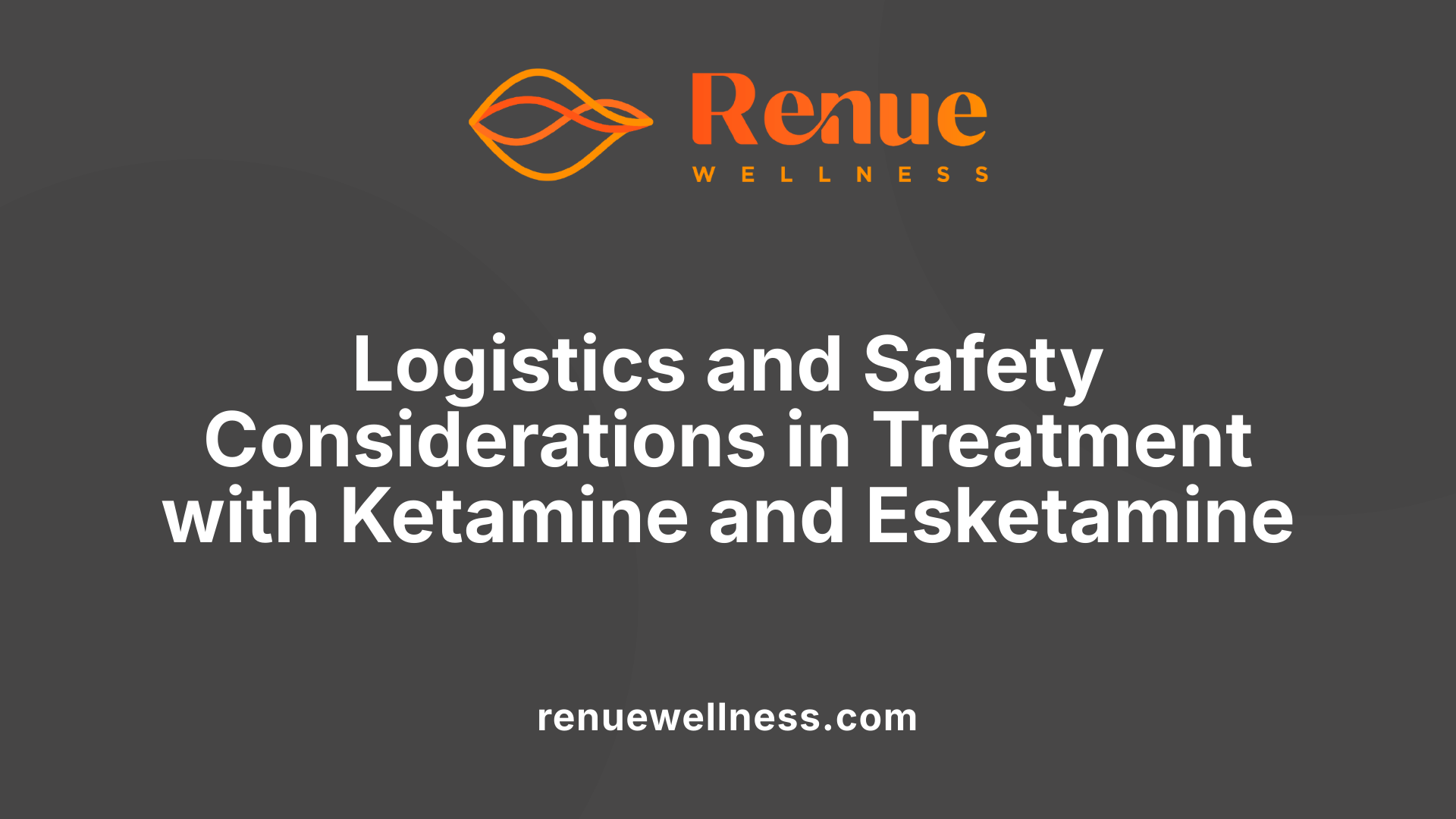Ketamine vs. Esketamine: Which Is Right for You?


August 8, 2025
Understanding Innovative Mental Health Therapies
The landscape of depression treatment has rapidly evolved with groundbreaking therapies that promise rapid relief and higher efficacy. Among these, ketamine and esketamine have emerged as frontrunners, offering hope for individuals with treatment-resistant depression and related conditions. This article delves into their mechanisms, uses, safety, and the key considerations guiding treatment choices, equipping patients and clinicians to make informed decisions.
Comparison of Chemical Structures and Mechanisms of Action

What are the differences between ketamine and esketamine in terms of their uses, mechanisms, and effectiveness?
Ketamine and esketamine are both medications that target the NMDA receptors in the brain, which play a role in mood regulation and neuroplasticity. They share a common mechanism—blocking NMDA receptors to increase glutamate levels and promote synaptic growth—but differ significantly in their chemical structures and how they are used clinically.
Ketamine is a racemic mixture, containing equal parts of two mirror-image molecules called enantiomers. The form most commonly administered is the racemic ketamine, which has been used for decades as an anesthetic. Its use in depression is off-label, typically administered through intravenous (IV) infusion or intramuscular injections. Ketamine has a proven rapid antidepressant effect, with success rates around 70-80% in treatment-resistant cases, and can even help reduce suicidal thoughts.
In contrast, esketamine is the S-enantiomer of ketamine, which makes it a more refined, purified version. It is more potent—requiring lower doses—and is FDA-approved specifically for treatment-resistant depression since 2019. Administered as a nasal spray (Spravato®), esketamine offers a more convenient and controlled delivery method, with patients monitored closely after each dose. This delivery route not only simplifies administration but also enhances safety and consistency.
The differences in structures influence their effectiveness and side effect profiles. Esketamine's higher potency allows for lower doses, which can reduce side effects such as dizziness, dissociation, or confusion. Though both treatments can cause transient side effects, esketamine's safety profile is well established, and it is often preferred due to its ease of use and FDA approval. Interestingly, recent studies suggest that IV ketamine may have slightly higher short-term response and remission rates than intranasal esketamine, though both are effective.
Ultimately, while both drugs work by modulating glutamate pathways to improve depressive symptoms rapidly, esketamine's approval status, administration method, and safety profile make it a more accessible and reliable option for many patients. Meanwhile, ketamine remains an economical and sometimes more effective alternative under medical supervision, especially in acute or resistant cases.
| Aspect | Ketamine | Esketamine | Key Differences |
|---|---|---|---|
| Chemical structure | Racemic mixture | Pure S-enantiomer | More potent, lower dosing |
| FDA approval | No (off-label for depression) | Yes | Approved for treatment-resistant depression |
| Administration | IV infusion, IM injections | Nasal spray | IV is faster in emergencies |
| Cost | Lower (~$187/session) | Higher (~$1,353/session) | Affordability varies |
| Side effects | Similar; dizziness, dissociation | Similar; dizziness, dissociation | Lower doses with esketamine |
| Effectiveness | Slightly higher short-term response | Effective, easier delivery | Both effective, IV may be more potent |
Both medications represent a significant advancement in depression treatment, capitalizing on their shared mechanism while differing in form, convenience, and regulatory approval. Proper selection depends on patient needs, response history, and access to care.
Administration Methods, Safety, and Logistics

Common administration routes for ketamine and esketamine
Ketamine is primarily given through intravenous (IV) infusion, providing 100% bioavailability and allowing precise control over dosage. This method involves delivering the medication directly into the bloodstream over 40-60 minutes and typically requires a series of 6-8 infusions over a few weeks. In contrast, esketamine (Spravato) is administered as a nasal spray, which is more convenient and less invasive. It is usually given twice a week during the initial phase, then less frequently for maintenance.
Monitoring procedures and safety considerations
Both treatments require close medical supervision due to possible side effects like dissociation, dizziness, nausea, and increases in blood pressure. Esketamine administration is conducted in a controlled medical setting, with patients monitored for at least two hours after each dose. Blood pressure is checked before administration, during, and after to manage cardiovascular risks. Patients with hypertension or cardiovascular issues need careful assessment prior to treatment.
Ketamine infusions also involve monitoring vital signs, especially blood pressure, and neuropsychiatric responses during and after treatment. Since both medications act on NMDA receptors and can cause dissociation or hallucinations, trained healthcare professionals manage dosing and observe for adverse reactions.
Logistical differences and challenges
Esketamine’s nasal spray format simplifies administration, making it suitable for outpatient clinics and potentially allowing for easier home use under supervision. However, scheduled visits and strict adherence to dosing protocols are necessary. Its approval requires enrollment in a Risk Evaluation and Mitigation Strategy (REMS) program to ensure appropriate use.
Ketamine infusions, while effective, pose logistical challenges such as the need for infusion centers, trained staff, and longer appointment times. They also tend to be more costly and less accessible for some patients, especially those without insurance coverage. Insurance coverage for ketamine is limited as its use for depression remains off-label, whereas esketamine’s FDA approval facilitates insurance reimbursement.
In summary, esketamine presents a safer, more standardized, and easier-to-administer option with rigorous safety protocols, while ketamine provides flexible dosing with personalized adjustment but involves more complex logistics and monitoring.
Treatment Contexts and Conditions
What are the primary medical uses of ketamine versus esketamine?
Ketamine has a long history as an anesthetic used in hospitals worldwide since the 1960s. It is primarily employed for induction and maintenance of anesthesia during surgical procedures, and it is also widely used for pain management, especially in emergency and postoperative settings. Its mechanisms also make it useful for managing certain chronic pain conditions, including neuropathic pain. Ketamine’s off-label applications include sedation in various medical procedures and guide its use in some mental health treatments, although these are not officially approved.
Esketamine, on the other hand, is a synthesized form of ketamine’s S-enantiomer. It was specifically developed and approved for the treatment of depression, notably treatment-resistant depression (TRD) and major depressive disorder with suicidal ideation. Unlike ketamine, esketamine is administered as a nasal spray under medical supervision, highlighting its suitability for outpatient settings. Its effectiveness and rapid onset—sometimes within hours—make it valuable for severe depressive episodes.
Approved indications and off-label uses
Esketamine was approved by the FDA in 2019 as a treatment for adults with TRD when used alongside oral antidepressants. It is also approved for major depression with suicidal ideation or behavior. These approvals were based on extensive clinical trials demonstrating rapid symptom relief, including reduction in suicidal thoughts.
Ketamine, while not FDA-approved for depression, is frequently used off-label in clinics and research settings for treatment-resistant depression. Patients often seek ketamine infusions or intranasal treatments as an alternative when traditional antidepressants have failed. Despite its off-label status, ketamine’s proven rapid antidepressant effects have prompted further research into its potential expanded use.
Conditions suitable for each therapy
Ketamine is most appropriate for:
- Surgical anesthesia
- Acute pain management
- Chronic pain and neuropathic pain
- Emergency sedation
Esketamine is ideally suited for:
- Treatment-resistant depression
- Major depression with imminent suicidal risk
The selection between ketamine and esketamine depends on various factors, including the specific medical condition, patient preferences, safety considerations, and insurance coverage. Esketamine’s controlled dosing and FDA approval make it more suitable for outpatient psychiatric settings, while ketamine’s versatile anesthetic profile keeps it valuable in broader medical contexts.
Personalized Treatment Decisions and Patient Considerations
Factors influencing choice between ketamine and esketamine
Choosing the appropriate treatment for depression with ketamine or esketamine depends on numerous factors. While both target similar brain systems involving glutamate, their administration routes, efficacy, and safety profiles vary. Intravenous ketamine is generally more studied, often less expensive, and may have slightly higher efficacy based on some research. Esketamine, administered as a nasal spray, offers increased convenience and is FDA-approved for treatment-resistant depression, which makes it a popular choice.
Role of medical history, preferences, and logistics
The decision-making process must consider a patient's medical history, particularly cardiovascular health, since both medications can influence blood pressure and heart rate. Patients with hypertension or heart issues may require careful evaluation before proceeding. Personal preferences regarding the treatment setting—such as intravenous infusions at a clinic versus self-administered nasal sprays—also influence choice. Cost and insurance coverage are significant considerations, as esketamine tends to be more expensive and not always fully covered, whereas ketamine infusions might be more affordable and accessible through certain providers.
Importance of professional guidance and ongoing assessment
A qualified healthcare professional is essential in guiding this decision. They will evaluate the individual's past treatment responses, side effect tolerances, and overall health. Regular monitoring after treatments—such as blood pressure checks and assessment of side effects—is crucial for safety and effectiveness.
How should individuals decide whether ketamine or esketamine is the appropriate treatment for depression or other conditions?
When deciding whether ketamine or esketamine is suitable, patients should consult a healthcare provider experienced in psychiatric treatments. The clinician will review their medical history, including any cardiovascular concerns or past substance use, and discuss treatment goals. They will also consider the patient's logistical preferences, such as whether they prefer outpatient nasal spray use or infusion sessions, and the financial aspects involved. Personalized plans based on these factors promote safer and more effective treatment outcomes.
Ongoing care and evaluation
Regardless of the initial choice, ongoing assessment is vital. Treatment responses can vary, and side effects may develop over time. Regular follow-ups enable adjustments to the therapy plan, ensuring optimal benefit and minimizing risks.
Efficacy and Comparative Effectiveness
Recent research comparing intravenous ketamine and intranasal esketamine provides valuable insights into their relative effectiveness for treatment-resistant depression.
Studies such as a 2023 meta-analysis involving 24 randomized controlled trials found that both treatments significantly reduce depressive symptoms shortly after administration. However, the data suggest that IV ketamine may outperform intranasal esketamine in response and remission rates. Patients receiving ketamine infusions often show higher overall response rates (approximately 70-80%) and remission outcomes compared to those treated with esketamine, which, while effective, tends to have slightly lower response numbers.
The duration of treatment effects also varies. Ketamine is known for its rapid onset, with many patients experiencing symptom relief within hours, and some studies indicate that its effects can last longer—up to a week or more—especially with repeated sessions. Esketamine similarly provides quick relief, often within hours, but its effects may diminish sooner without ongoing maintenance.
Cost-effectiveness is another important factor. IV ketamine treatments are generally less expensive—averaging about $187 per session—and are often covered by Medicare. In contrast, esketamine treatment sessions can cost up to $1,353, though most insurance plans do provide coverage after prior authorization. The lower cost and higher convenience of IV ketamine make it a preferable option for many patients.
Patient tolerability and side effects are nearly identical for both medications, with common mild effects including dizziness, nausea, dissociation, and increased blood pressure. Both treatments require monitoring post-administration for safety.
In summary, while both ketamine and esketamine are effective rapid-acting treatments for depression, recent studies highlight ketamine’s greater efficacy, longer-lasting effects, and lower costs. Nonetheless, esketamine’s FDA approval and easier nasal spray administration make it a popular choice, especially when insurance coverage and treatment convenience are priorities. The ultimate decision depends on individual needs, medical history, and personal preferences, emphasizing the importance of consulting healthcare providers for a tailored treatment plan.
Making an Informed Choice in Depression Treatment
Choosing between ketamine and esketamine involves weighing effectiveness, safety, convenience, cost, and personal health factors. While ketamine offers a more established, potentially more efficacious, and cost-effective option with flexible administration routes, esketamine's FDA approval and ease of use as a nasal spray make it a compelling choice for many patients. Consulting with specialized healthcare providers to evaluate your specific needs, health history, and treatment goals will ensure the most suitable and safe option, ultimately supporting better mental health outcomes in the fight against depression.
References
- Ketamine vs Esketamine: Critical Differences Explained
- The Difference Between Esketamine vs Ketamine | Spravato®
- The Difference Between Ketamine and Esketamine (Spravato) for ...
- Ketamine and Esketamine Therapy
- Study: Intravenous Ketamine Vs. Intranasal Esketamine
- Spravato vs. Ketamine Infusion: Which Treatment Is Right for You?
- Comparative efficacy of racemic ketamine and esketamine for ...
- Ketamine vs Esketamine | Neuro Wellness Spa
Recent Posts
Conditions Treated
AnxietyDepressionOCDPTSDPostpartum DepressionPain ManagementSubstance AbuseSuicidal IdeationOur Location


